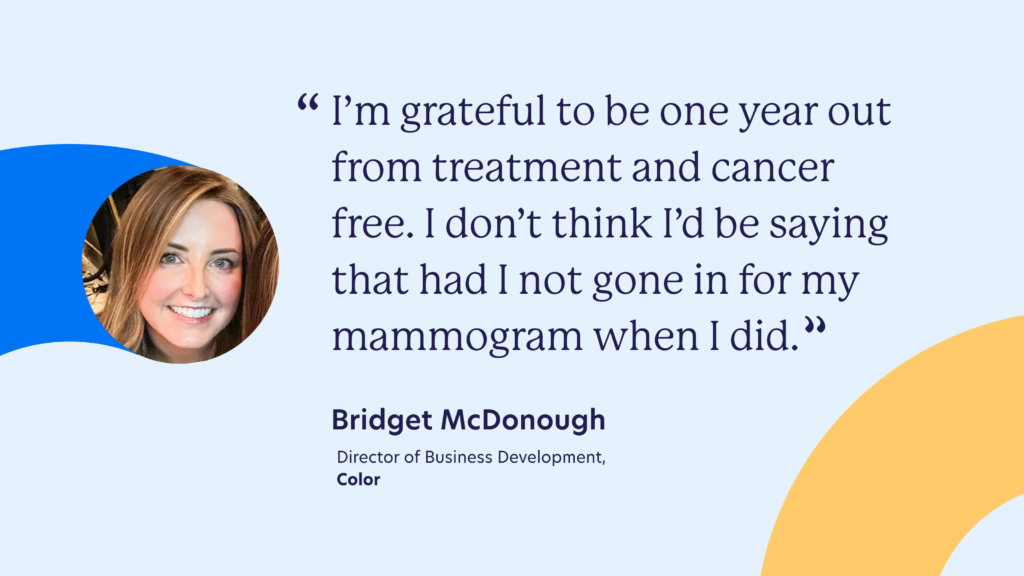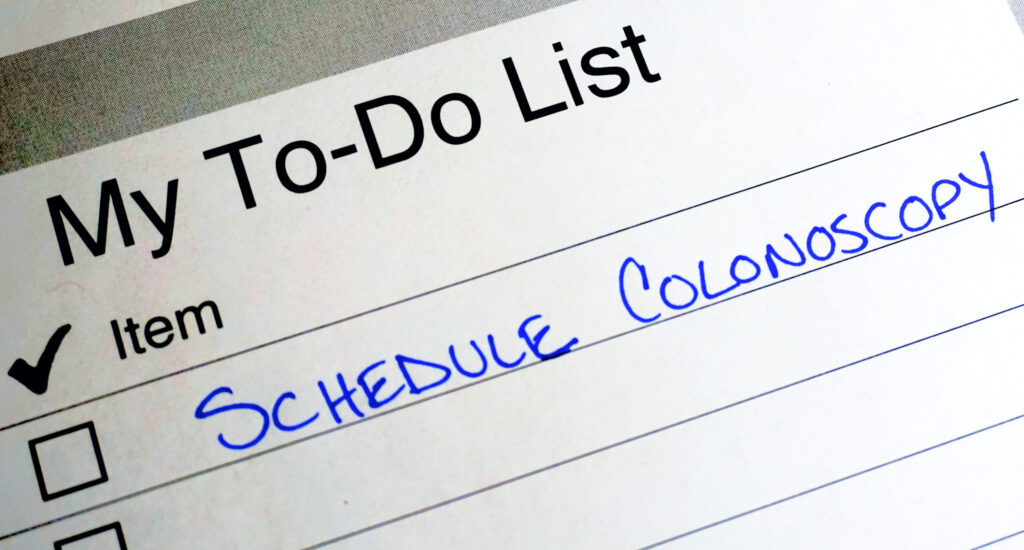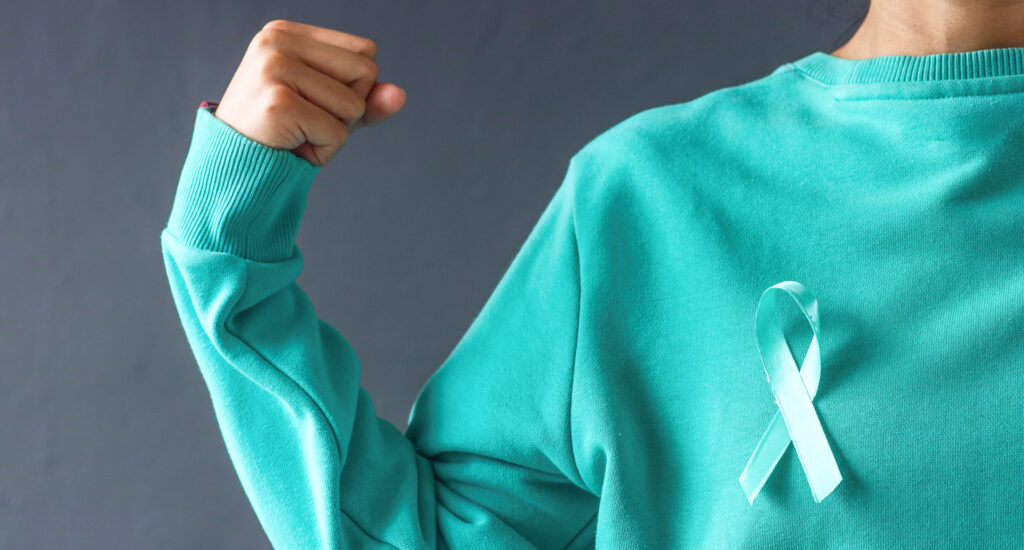News & Articles
As a breast cancer survivor, here’s what I tell workforces about getting screened
Color

Bridget McDonough is a Director of Business Development at Color. Every day she helps organizations deploy better strategies for detecting and helping to prevent cancer. She is a breast cancer survivor.
The following is a Q&A with Bridget.
Hello, Bridget! If someone reading this blog were about to click away from it, what is one thing you want them to know before they go?
Earlier diagnosis means better prognosis. Many people with breast cancer have no symptoms. I had no symptoms. It’s common for breast cancer to appear on a mammogram before a lump can be felt. We have many tools to detect breast cancer early and we need to use them. Getting screened regularly and understanding your personal risk is SO important and deserves to be prioritized.
What’s the story behind your diagnosis? How did you first find out you had breast cancer?
In January of 2022, I was 40 years old and I started the year off with my annual gynecology appointment. My doctor and I spent some time discussing my family history. I come from a very large family, and my father had just passed away, so it was top of mind during that visit. Breast cancer was not something that ran in my family though. I proactively asked my doctor if I should get a mammogram, and she said it was something I could think about.
Because my doctor saw nothing concerning, she said there was no rush. I was told the office would follow up with me about getting the mammogram scheduled. A few weeks after that appointment, I realized I had never heard from anyone about scheduling a mammogram and wondered if I should call the radiology practice myself. I called and they said they did not have a record of a referral from my doctor, but since I was over 40 years old, I could “self-refer” myself. Also, they said I should be aware that they did not have any appointments available for several months due to a backlog from the COVID-19 pandemic.
So… you just had to wait?
Yes. A few months passed, and I went in for my mammogram in April of 2022. I was told that since it was my first mammogram, I should not be concerned if I got called back in for an “abnormal” result.
So when I was called back in, I was not concerned. Over the next several weeks, I was brought back several more times for more tests, ultrasounds, and biopsies. I eventually received a call from my doctor’s office asking if I could come in to see them immediately.
As I entered the office, I could see the concern on the faces of the staff. I already knew what I was about to hear. What I didn’t know was what would come next.
What happened?
It wasn’t what I saw on television or in the movies where the patient and their loved ones sit in an inviting office with a physician and all the next steps were thoroughly explained. I was in an exam room and handed a pathology report and a business card with the name of a local breast surgeon, and I was sent home. I had no idea what the next step was or how bad my diagnosis was. There were so many open questions I still had and I was desperate for some sort of roadmap to navigate this. Following that day, I spent time researching, learning (and googling) what to do next.
After what felt like a lifetime, I eventually found the care team who would support me throughout this journey I was embarking on, and they were incredible.
Prior to establishing my treatment plan, a breast MRI was ordered for me to confirm the previous findings. I was unexpectedly found to have synchronous bi-lateral breast cancer- not one, but two tumors. Both were fortunately caught early, but having this information prior to going through surgery and treatment was invaluable.
I was faced with many decisions and many treatment options moving forward, and it was not easy to go through, but I am very confident now that those early screens saved my life.
What did you find most difficult about the detection process?
Waiting! It’s an emotional rollercoaster. There is a lot of waiting between scans/tests/biopsies. I constantly had the Tom Petty song running through my head… 🎵The waiting is the hardest part 🎵
I also found it difficult to manage the decision-making process. Once something is detected, you’re faced with SO many decisions and a new medical language that you may not be familiar with. It’s often hard to make sense of what happens next and if you’re making the right choices.
What do you find that people misunderstand about mammograms?
They underestimate the ease and effectiveness of screening. Mammograms are more advanced than they used to be. They are not perfect (no screening tool is), but they can be life-saving. Regular screening can catch cancer in early stages when it is more treatable, before it spreads.
People also mistakenly think feeling good physically and having no visible signs of cancer means screenings are not necessary—that you only go to the doctor when you feel sick or feel something abnormal. That’s not exactly true.
Prior to getting my first mammogram, I thought it was going to be painful and time-consuming, and I made excuses as to why I wasn’t prioritizing it. I still felt “young and healthy” and considered it an inconvenience. I can personally say that of all the things I experienced going through cancer, getting a mammogram was the easiest, least time-consuming and least painful part.
In terms of your overall cancer journey, what are you most grateful for?
It’s hard to only provide one thing…cancer has taught me so many lessons and I’m grateful for so much more than I would have ever anticipated.
I’m grateful to be one year out from treatment and cancer free. I truly don’t think I’d be saying that had I not gone in for my mammogram when I did. I can’t stress enough the importance of early screening.
I’m grateful that early detection has set me on a path to spend many more years with my friends and family. It really helped me understand the importance of prioritizing my health because it not only impacts me, but the people closest to me.
What motivates you to do the work you do at Color?
Well before I was diagnosed with cancer, I chose to join Color because the mission had been something that really resonated with me and something I felt passionate about. A former colleague of mine once said, sometimes you go seek out a mission and sometimes the mission finds you. I believe that’s true. I’m now more motivated than ever to continue my work at Color because with personal experience comes a deeper understanding of why what we are doing at Color is so incredibly important for all organizations.
I love to connect with people, and if I can impact someone’s life and health for the better even in the slightest way, I feel successful. I’m excited to be able to share our Cancer Prevention and Screening Program for Employers and Unions, created in partnership with the American Cancer Society. Hopefully the program provides others the opportunity to take action in the ways I could.
What do you tend to recommend to organizations who are concerned with rising rates of cancer in their members and employees?
One thing we all agree on is that cancer affects all of us in one way or another. Employers and Unions have an opportunity to make a huge impact in the lives of their members and employees. The single most effective thing we can do in the fight against cancer is to increase our screening rates and catch cancer at earlier stages.
Cancer is something that can no longer be overlooked. It is not the easiest topic to discuss, but it is important to provide members and employees with the education needed to prevent cancer and the access to get screened.
As a survivor, how do you honor Breast Cancer Awareness month?
This is actually my first year celebrating Breast Cancer Awareness month as a survivor. I have friends and family who have organized events that I am taking part in and I plan to attend the American Cancer Society’s Making Strides Against Breast Cancer walk in my community.
My hope is that by sharing my story with more people this month (and the months following), it will help others understand the importance of getting screened early. Don’t wait. No excuse is worth it.
This Breast Cancer Awareness Month, you can make critical steps toward lessening the impact of breast cancer in your organization. To learn more about Color’s Cancer Prevention & Screening Program, in partnership with the American Cancer Society, visit color.com/cancer.



